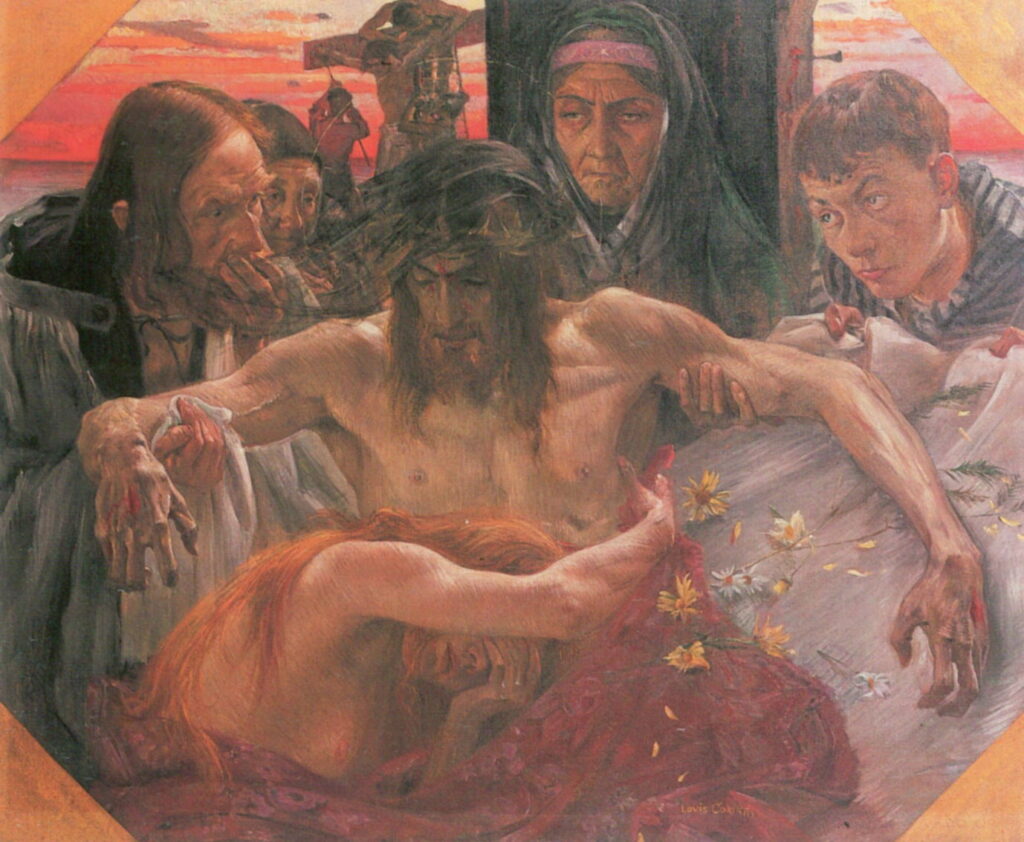Easter Paintings: 2 The Crucifixion

In this second of my three articles devoted to paintings of Easter, I cover the Crucifixion, from Christ’s ascent to calvary bearing his cross, to the entombment of his body.
Way of the cross
Jacopo Tintoretto (c 1518-1594), Ascent to Calvary (E&I 128) (1566-67), oil on canvas, 285 x 400 cm, Albergo, Scuola Grande di San Rocco, Venice, Italy. Image by Sailko, via Wikimedia Commons.
Jacopo Tintoretto’s Ascent to Calvary (E&I 128) is unusual among paintings of this phase of the Passion for its inclusion of all three of those to be crucified bearing their crosses. Christ is naturally prominent in the upper half of a composition dominated by diagonals, formed by the winding path and the crosses themselves. He and the two thieves are each given assistants who help them with the burden of the crosses.
In the upper distance are banners declaring the oversight of the Roman authorities, in their inscriptions of SPQR. Tintoretto links this with the Crucifixion with the inclusion of the tradesmen and their tools who were shortly to be responsible for the mechanics of the executions. Here the thick ropes bind the figures together, as they are used to attach the crosses to their bearers, and to draw the three along to their deaths.
Lovis Corinth (1858–1925), Christ Carrying the Cross (1909), oil, dimensions not known, Städelsches Kunstinstitut und Städtische Galerie, Frankfurt. Wikimedia Commons.
Lovis Corinth’s Christ Carrying the Cross (1909) explores Christ’s Passion in real terms. Although this contains most of the usual elements seen in traditional depictions, his language is contemporary, almost secular. Two men, one of them apparently African, are helping Christ bear his exhausting load, while a couple of soldiers are whipping him on, and threatening him with their spears. A third soldier is controlling the crowd at the upper left, and behind is a mounted soldier and one of the disciples.
Crucifixion
Jacopo Tintoretto (c 1518-1594), The Crucifixion (E&I 123) (1565), oil on canvas, 536 x 1224 cm, Albergo, Scuola Grande di San Rocco, Venice, Italy. Wikimedia Commons.
Tintoretto’s Crucifixion (E&I 123) (1565) is over 5 metres (17 feet) high, and 12 metres (40 feet) across. The artist makes use of space with a narrative technique based on the traditional ‘multiplex’ form popular during the Renaissance: its single image shows events at more than a single point in time, in an ingenious and modern manner.
Jacopo Tintoretto (c 1518-1594), The Crucifixion (detail) (E&I 123) (1565), oil on canvas, 536 x 1224 cm, Albergo, Scuola Grande di San Rocco, Venice, Italy. Wikimedia Commons.
Naturally, the painting centres on Christ crucified, but the two thieves executed beside him are not shown, as would be traditional, already hanging from their crosses. Instead, to the right of Christ, the ‘bad’ thief is still being attached to his cross, which rests on the ground. To the left of Christ, the ‘good’ thief is just being raised to the upright position.
Spaced out around the canvas are relevant sub-stories from that whole. At the foot of Christ’s cross is his group of mourners, including the Marys. Each of the crosses has attendant workers, busy with the task of conducting the crucifixion, climbing ladders, hauling on lines, and fastening each victim to his cross. This mechanical and human detail brings the scene to life, adding to its credibility and grim process.
James Tissot (1836-1902), What Our Lord Saw from the Cross (1886-1894), opaque watercolor over graphite on gray-green wove paper, 24.8 × 23 cm, Brooklyn Museum, New York, NY. Courtesy of Brooklyn Museum, via Wikimedia Commons.
James Tissot’s What Our Lord Saw from the Cross is a uniquely innovative and narrative depiction of the crucifixion.
Descent from the Cross
Peter Paul Rubens (1577–1640), Descent from the Cross (centre panel of triptych) (1612-14), oil on panel, 421 x 311 cm, Onze-Lieve-Vrouwekathedraal, Antwerp, Belgium. Image by Alvesgaspar, via Wikimedia Commons.
Peter Paul Rubens painted a huge panel showing the Crucifixion, although in this case it’s strictly speaking a Deposition: this centre panel, Descent from the Cross (1612-14), is from his triptych commissioned by the Confraternity of the Arquebusiers of Antwerp for the Cathedral of Our Lady in that city. This remains one of Rubens’ greatest religious paintings.
Lovis Corinth (1858–1925), The Deposition (1895), oil on canvas, 95 × 102 cm, Wallraf-Richartz-Museum, Cologne. Wikipedia Commons.
The Deposition (Descent from the Cross) (1895) was one of Lovis Corinth’s major paintings from his time in Munich, and won a gold medal when it was exhibited in the Glaspalast in Munich, in 1895. It shows the traditional station of the cross commemorating the lowering of the dead body of Christ from the cross, attended by Joseph of Arimathea and Mary Magdalene.
This work is a thoroughly modern approach to this classical theme, in its framing, composition, and the faces. Its close-in cropped view suggests the influence of photography, and the faces shown appear contemporary and not in the least historic. These combine to give it the immediacy of a current event, rather than something that happened almost two millennia ago. Corinth returned to the subject of the Deposition, and the theme of the Crucifixion, in many of his paintings.
Pietà
Gustave Moreau (1826–1898), Pietà (c 1876), oil on panel, 23 x 16 cm, National Museum of Western Art 国立西洋美術館 (Kokuritsu seiyō bijutsukan), Tokyo, Japan. Wikimedia Commons.
Gustave Moreau painted several versions of the Pietà (c 1876), this one on a tiny panel. It incorporates some of the more radical imagery which was appearing in his mythological paintings, with a blue wing in the centre.
Entombment
William Blake (1757–1827), The Entombment (c 1805), ink and watercolour on paper, 41.7 x 31 cm, The Tate Gallery (Presented by the executors of W. Graham Robertson through the Art Fund 1949), London. © The Tate Gallery and Photographic Rights © Tate (2016), CC-BY-NC-ND 3.0 (Unported), http://www.tate.org.uk/art/artworks/blake-the-entombment-n05896
William Blake’s The Entombment (c 1805) refers to the gospel of Luke, chapter 23 verses 53 and 55:
And he took it [the body of Jesus] down, and wrapped it in linen, and laid it in a sepulchre that was hewn in stone, wherein never man before was laid.
And the women also, which came with him from Galilee, followed after, and beheld the sepulchre, and how his body was laid.

